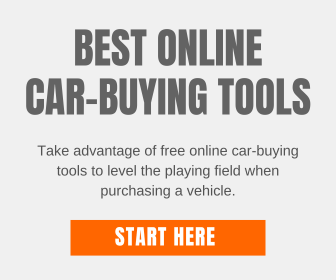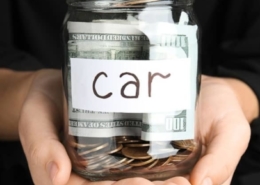How Much Car Can I Afford?
Car buying guides – this one included – always stress the importance of setting a budget before you start shopping. The reason is that you’re likely to leave the dealership without a hard limit, having spent much more than you wanted. You may even have spent more than you can afford. But how do you decide on a boundary?
Once you know how much you can afford for a monthly car payment, you can figure out how much you can borrow for a car loan. With this information, you can set a reasonable target price and finally respond to the question, “What car can I afford?”
A Better Question to Ask Yourself
If you’re a prudent saver, you’ll be paying cash, and you don’t intend to part with more than you have squirreled away. Most car buyers lack discipline, though, so dealerships began setting up financing for car buyers.
When you finance, you’re borrowing money and paying it back over time. Buying a car becomes easier but figuring out what you can afford is much more challenging. In fact, rather than asking, “How much car can I afford?” you should be asking yourself, “How long will I want to keep my next vehicle?” Here’s why.
Reducing the Monthly Payments
Whether leasing or buying, the tendency is to consider the monthly payment. The problem is that it’s straightforward to reduce the monthly outgoing. All you need to do is extend the term of the loan or lease. To ignore the impact of interest for a moment, if a three-year loan will cost $700 per month, spreading it over six years cuts it to $350 per month.
If you’re wondering who takes out a six-year car loan, the answer is lots of people. (Perhaps they don’t take advice from autocheatsheet.com!)
An article from June 2016 in Forbes magazine reported car loan data from Experian. This said, the average amount financed for a new car was $32,000, the average monthly payment was $503, and the repayment term was 68 months or almost seven years.
The Downside of Lower Monthly Payments
Two reasons are why spreading a loan out over a more extended period isn’t a good idea. First, you’ll be paying a lot more interest, and even if you double the loan period, the monthly payments won’t halve. Second, you’ll be driving that car for the next six years. If you love it, that might not be a problem, but what if things change? For example:
Unforeseen future issues:
- Gas prices jump, and you need something more economical.
- Your family circumstances alter, and you need a larger car or want something smaller.
- You want a vehicle with new technology that wasn’t available when you bought yours.
- Reliability starts to become a problem, and you’re spending more and more on repairs.
This last point – reliability – can be a huge issue. New cars come with warranties of three years, sometimes longer, but after that, you’re on the hook if anything goes wrong. In addition, the likelihood of expensive repairs or maintenance rises quickly as a vehicle ages. For example, there will be new shock absorbers and maybe a brake fluid flush or two.
Get Out of a Loan Early
A car salesperson might tell you not to worry about a longer-term loan because you can get out of it early. That’s true, but it’s not relatively that easy. Two things can happen:
Possible issues trading your car early:
- The remaining loan balance doesn’t just go away. Instead, it gets rolled into the next loan, so you’re paying it off over a longer-term and paying even more interest.
- If you try to get out of a six-year loan after just two or three years, you’ll likely be “underwater” or “upside-down,” to use some car salesman jargon. That means you’ll owe more than the car is worth, so selling it won’t raise enough cash to pay off the outstanding balance.
Figuring out Affordability
Once you’ve got a feel for how long you want to be committed to a car, you can start looking at what you can afford. Some easy-to-use calculators available online show what you could spend for a given monthly repayment and loan term. (The affordability calculator at cars.com is excellent.)
One of these beauties is that they let you weigh up alternative scenarios. For example, you can see how much difference the down payment size makes or the impact of a lower interest rate. (That might encourage you to work on improving your credit score!) You can also enter the Forbes/Experian numbers mentioned earlier to conclude that new car buyers must be making a down payment of more than $10,000.
Still unanswered, though, is the question of the monthly payment. How do you arrive at that number?
Budgeting for Your New Car
That paragon of sensible advice, Consumer Reports, suggests performing a cash flow analysis. Note down all your monthly outgoings – rent or mortgage, utilities, food, and so on – and deduct the total of those from your after-tax income. But don’t think what’s left is available for a new car! You’ll probably have to pay tax and registration fees on the vehicle, and you should always leave a buffer for the unexpected.
CR also suggests heeding the 20/4/10 rule sometimes trotted out for car buying. This means you should aim to put at least 20% down, limit the term to four years, and spend no more than 10% of your gross income on monthly payments. Read more about this in my article “How Much Cash Down on a Car?”
Budget for Your Car Two Ways
Buying a car is different from buying just about anything else. While there are many practical aspects to consider, it’s a decision made with the heart and the head. That means there’s a risk of getting carried away and spending more than you can afford (which, of course, is what the salesman would like!)
The answer is to figure out a budget, but unless you’re paying cash (lucky you!), don’t think only about the actual price. Consider how long you want to be making payments on it and what kind of monthly sum you can afford. Only then will you know exactly how much car you can afford.
Be a Smart Car Shopper
Car shopping online is the smart thing to do. It’s easier than the old way of sorting through dozens of misleading newspaper ads or trudging around dealerships. And since dealerships look at online car deals as “high volume – low profit” transactions, you’ll probably get a better deal. Do yourself a favor and make online car shopping the way you buy your next car. For more hints and tips on navigating the new and used car buying process, please browse the rest of my website AutoCheatSheet.com.
Once you’ve figured out your budget and are ready to start shopping for your next new or used car, take a look at either my “New Car Buying Tips” or “Used Car Buyer’s Tips” for insider tips and secrets on how to buy a car and avoid dealer scams.
I recommend using an online referral service such as Ryde Shopper or Motor Trend before visiting a car dealership. Their free online price quotes will automatically include any discounts or cash-back incentives currently available in the marketplace.














